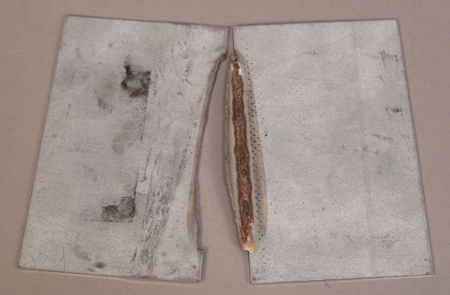
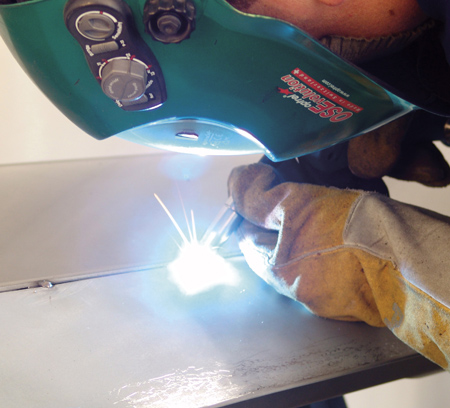
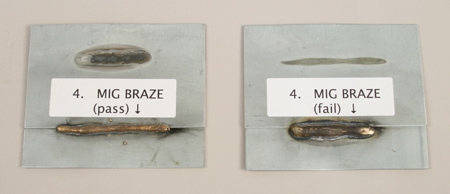
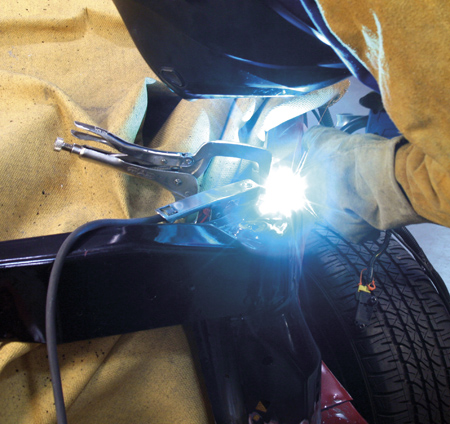
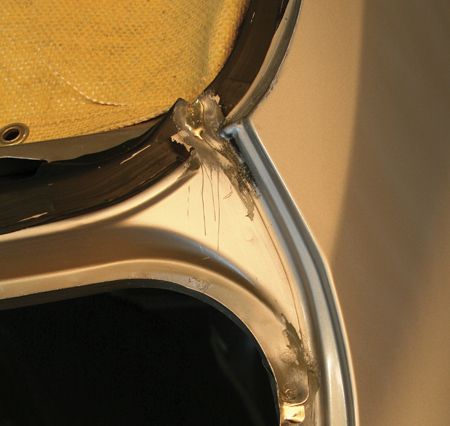

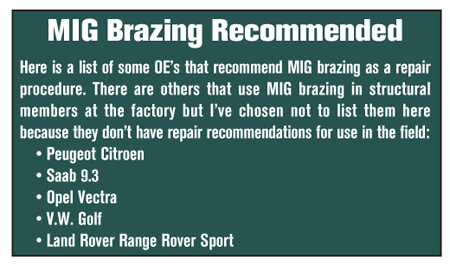 Brazing is back? Well, maybe it is, or, quite possibly for you, it was never there in the first place. But if you’ve been a collision repairer for more than 25 years, then it is back. Otherwise, you probably have only been exposed to MIG steel welding and may have never oxyacetylene welded or brazed at all which, at one time in our industry, was the primary way we welded.
Brazing is back? Well, maybe it is, or, quite possibly for you, it was never there in the first place. But if you’ve been a collision repairer for more than 25 years, then it is back. Otherwise, you probably have only been exposed to MIG steel welding and may have never oxyacetylene welded or brazed at all which, at one time in our industry, was the primary way we welded.
All About the HAZ
Brazing was done with a gas torch to minimize distortion and heat build-up. With the advent of the unibody vehicle, the use of High Strength Steels (HSS) came into being. We realized that the large heat affect zone (HAZ) that’s normal with oxyacetylene welding and brazing would compromise the high-strength properties of the thin and light weight HSS.
Automotive engineers love HSS because it allows them to create a lightweight, fuel-efficient automobile. But dang it, it has to be repairable with structural parts replacement in the field. Conventional oxyacetylene welding that had been used for at least 80 years prior to the mass debut of the unibody around 1979 wasn’t going to cut it because it was too compromising and destructive toward lightweight HSS.
We did have Gas Metal Arc Welding (GMAW) or Metal Inert Gas (MIG) welding, though. It wasn’t widely used in the U.S. automotive industry but it was used in fabrication, construction and manufacturing. That was back when we had a manufacturing industry!
We began by importing compact quality MIG welders from Europe. Most available U.S.-made machines at that time were large and cumbersome and not really designed for the collision repair industry. The European machines, however, were designed for us, but then again they had been building lightweight, fuel-efficient cars longer than we had. Necessity is the mother of invention, so to speak, and the Europeans had the need, met that need and have been meeting it for years with fine quality MIG welders for collision repairers.
Many years later, our own American MIG welder manufacturers met the challenge and built quality, compact machines for us, too. It took awhile, but I think they also had thought of collision repair as a small niche market not worth fooling around with. I’m happy to say, though, that they revised this way of thinking.
MIG Weld vs. MIG Braze
So for at least 25 to 30 years, the MIG welding process has been a common standard in the collision repair industry. Several years ago, it was joined by Squeeze Type Resistance Spot Welding (STRSW). Of course, we’ve had TIG (Tungsten Inert Gas) welding around for years, but it isn’t widely used because it has many of the characteristics of oxy-acetylene welding. It has the slowest deposition rate of any electric welding process and therefore has a large HAZ – not good on HSS or Advanced High Strength Steels (AHSS). Why? Because when the base metal melts, it changes the characteristics it was designed for. In addition, there’s an element of corrosion protection that’s compromised by fusion welding (melting two or more base metals together with the addition of a filler rod).
With the exception of some AHSS, many structural steels are galvanized to protect them from rusting when the paint is compromised in some way. When MIG welding steel, this zinc galvanization vaporizes in the joint because of temperature (approximately 3,000° F) that far exceeds the melting temperature of zinc. In fact, it gets so hot, the zinc vaporizes at the joint, leaving the base metal unprotected in the HAZ.
With MIG brazing, the issue of compromised design characteristics and strength, as well as the lessening of corrosion protection in the joint area, are dramatically reduced because of the much lower temperature (1,940 degrees Fahrenheit). Depending on the thickness of what you’re brazing, the zinc may reflow back into the joint. In any case, with a much smaller HAZ, there will be a much smaller area where the zinc coating was compromised.
So, our main reasons for MIG brazing are: retention of designed strength at the joint site and enhanced corrosion protection over fusion welding.
Limited Use
Before we take off down a rabbit trail with the idea that MIG brazing is the new method of joining for every situation, stop and be warned! MIG brazing has very limited application and should only be used where the OE recommends it and not anywhere else.
Engineers are funny about these things. They design in the crash-ability aspects of a repair method, and certainly the attachment method is a major aspect. It isn’t unlike the abuse of adhesives in our industry. Some OEs don’t recommend the use of adhesives without welding, but there are repairers who glue on any panel without regard for the OEs’ recommendations, which is a recipe for failure.
MIG brazing is not a universally recommended process, which means it should be used where it is recommended and not used where it isn’t…period.
Don’t Stab in the Dark
MIG brazing can be as easy or as difficult as you make it. It’s not unlike what has been said about aluminum repair and welding: It’s not difficult, it’s different. If you start out with the recommended equipment and technique, it will go a lot easier than taking the “stab in the dark” approach. Start with recommendations from reliable sources, adjust accordingly from there and success will be yours.
A pulsed spray arc process works best. To you, that means that a pulsed spray arc welder is a recommendation. These machines are advanced and are used for thin aluminum because they give you the ability to weld 1-mm aluminum without burn-through. This process works just as well for MIG brazing.
A pulse welder alternates current rapidly between 220V and 120V, which differs dramatically from our constant voltage MIG welders that most of us use to weld steel in our shops today. Because of the low melting temperature of the bronze alloy wire, a pulse welder is desirable to control the heat and stabilize the process.
Many pulse welders have computer programs installed for specific procedures such as MIG brazing. These will automatically set wire speed and voltage for the specific process you’re doing. Fine tuning takes place from there. These features aren’t cheap but will save you time and allow you to avoid manual setup. If you balk at the cost, remember that this pulsed spray MIG machine will provide you with the ability to properly weld aluminum, too, so it expands your capabilities, not to mention keeps you current with technology.
Both the conventional MIG gun and a spool gun are available in pulsed spray arc machines. The conventional MIG gun, of course, will give you enhanced access over a spool gun…usually at a price. The drive systems in the conventional style are very advanced, enabling them to feed these softer wires through a three-meter liner without bird nesting. On a spool gun, the liner is only about an inch long, so driving the wire isn’t an issue. U-shaped drive rolls are recommended over V-shaped. Also, it’s recommended to have dedicated drive rolls and liners for just the MIG brazing process to prevent cross contamination between the aluminum welding wire and the MIG brazing wire. The liners used for MIG brazing should be the Teflon type to aid the easy passing of the wire through the liner.
Wire and Gas
The electrodes most commonly used for automotive repair are alloys of copper. The alloying elements used with copper are either silicon or aluminum. The European designation for these wires is Cu Si 3 and Cu Al 8. The numbers are indicators of the percentages of the alloying element in the copper. In other words, 3 percent silicon in Cu Si 3 and 8 percent aluminum in Cu Al 8. The American equivalent for these are Cu Si 3 = Cu Si A and Cu Al 8 = Cu Al A2. The wires are commonly available in .025, .030 and .045 diameters.
If you’re already welding aluminum, there’s good news: You don’t need some new obscure gas mixture. It’s the same as the recommended gas for aluminum – 100 percent argon. Set your regulator at 25 to 30 cfh and you’re good to go.
Once you have a machine set up for this process, it will most likely become a dedicated machine for MIG brazing and MIG welding aluminum. Make sure to mark your liners and drive rolls accordingly for ALUM or BRAZ.
It’s All in the Technique
Okay, you’re set up with the proper wire and welder. Now you need to set up your machine based on the size or thickness of the base metals you’re brazing. If it’s cosmetic you’re working on, of course your settings are going to be lower than for structural. This holds true for your electrode wire also.
Set up test welds on comparable gauge material from the damaged parts of the vehicle you’re working on. Don’t expect the appearance of the properly executed MIG braze bead to look like that of a steel weld it shouldn’t. It should have the appearance of a cold steel weld.
Do not attempt to get the MIG braze bead to lay down or flow out. This defeats the purpose of using this process, which is to reduce heat and stress in the weld site in order to maintain strength and corrosion protection.
Your gun angle should be around 60 degrees away from the weld site (tipped back), and you should use the push technique. This gun angle will vary from 45 degrees to 90 degrees, depending on the joint and location. The recommended pushing versus dragging or pulling the gun helps preheat the site and provide a stable arc and a pollution-free weld site.
Your main joints will be lap joints (one sheet on top of the base metal), a butt weld with backing, an open butt weld and a slot weld. Plug welds aren’t recommended welds due to the cold start aspect of MIG brazing. By the time you’ve turned the machine up high enough to perform a MIG weld, it’s too hot to preserve the characteristics you’re trying to protect in the joint. Use a slot weld instead.
A completely tight lap, as in a MIG steel joint, isn’t as desirable as one with a very slight open aspect to it (.05 to 1-mm). This allows better capillary action to occur.
Self-Destruct
Destructive testing of your test welds is essential. Clamp your test weld coupons in a vice and peel the top sheet from the bottom with locking pliers. You must achieve “tear out” at the weld joint of the test coupons. Part of the peeled coupon must remain in the MIG-brazed bead that remains on the bottom coupon. This is how you know your machine is set up correctly and your technique is right. If you don’t destructive test your test welds, you’re just guessing. Not good!
Perform the welds as stated in the OEMs’ recommended procedures. When finishing the MIG braze joint, use a 50 to 80 grit sanding disc with low pressure. This is a soft metal, so take care and don’t over grind. The joint should appear free of voids or cracks.
Know Your Limits
As you can see, MIG brazing is a viable attachment method that will maintain the designed-in metallurgical characteristics of HSS, Ultra-High Strength Steel and Advanced High Strength Steel, as well as protect built-in corrosion protection at the joint site.
The process has limited OE-recommended uses as a repair process at this time. Just because you may find MIG brazing being used as a factory process, don’t assume that it will be the OE-recommended repair process.
Be aware and may all your repairs be successful!
For more information on MIG brazing, I suggest taking the online I-CAR MIG Brazing course BRZ01.
Writer Mike West, a contributing editor to BodyShop Business, has been a shop owner for more than 30 years and a technician for more than 40 years. His shop in Seattle, Wash., has attained the I-CAR Gold Class distinction and the ASE Blue Seal of Excellence.













